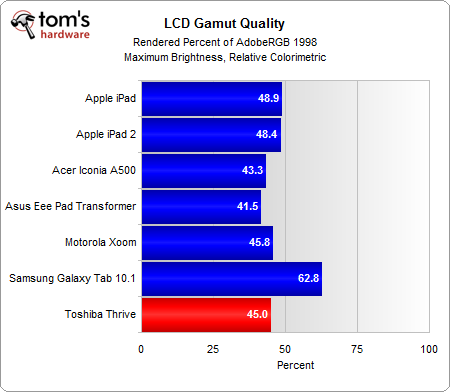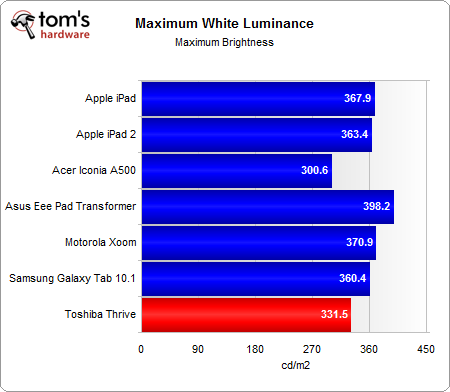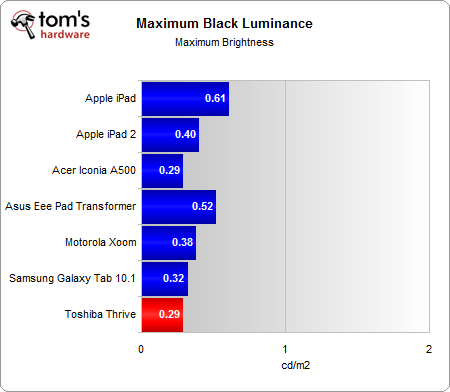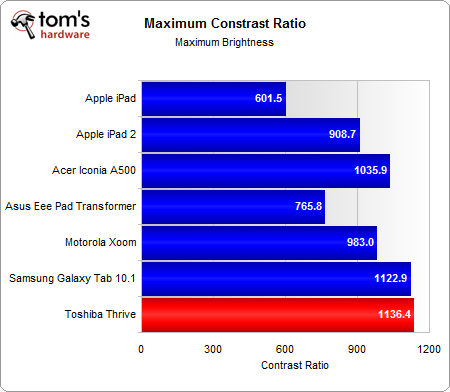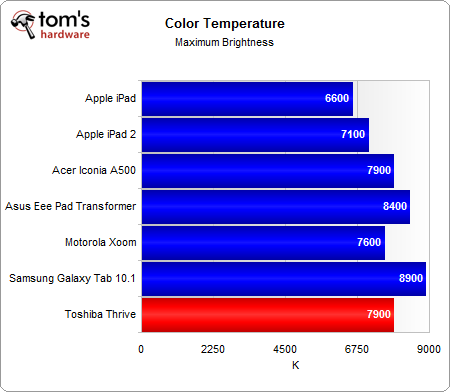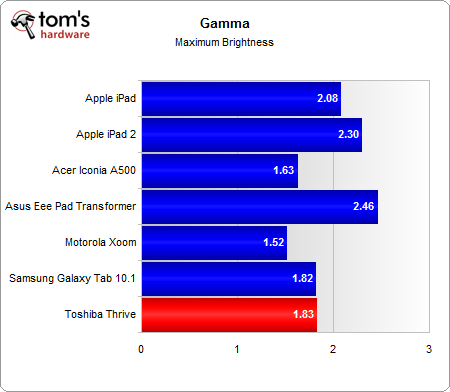Toshiba Thrive Review: The Swiss Army Knife Of Tablets
Display Quality: Color Gamut
Toshiba doesn't tell us what type of panel it's using on the Thrive, but the company commonly describes it as IPS-like. As a result, most publications say that the Thrive uses an IPS display.
In our opinion, this tablet's viewing angles are decent, but not as good as competing models like Asus' Eee Pad Transformer or Apple's iPad 2 (tablets that we know for certain employ IPS technology). This makes IPS an unlikely option.
Pulling out our Celestron lab microscope confirms our suspicions. Based on the subpixel structure, the Thrive uses a VA panel, which explains how this tablet achieves deep blacks.
Even though mobile operating systems don't honor ICC color profiles, native color management does occur at the hardware level. When a GPU sends 10 different hues of blue to an LCD only capable of displaying three, the subpixels display the closest matching color. So, in a way, smartphones and tablets behave as if they’re using relative colorimetric rendering. For more information, read Tom's Hardware Benchmarks Inkjet Printer Paper!
Most tablets still deliver less color quality than the cheap TN panels we see on the desktop, which is why the Thrive doesn't surprise in this test. Overall color gamut is extremely close to the A500. The Galaxy Tab 10.1's Super PLS panel still sets the standard when it comes to display quality. There isn't a tablet we've seen able to match it.
These gamut measurements are accompanied by a couple of caveats. First, we're disabling dynamic brightness because it doesn’t allow us to get an accurate (or reproducible) measurement of the display’s potential. Second, brightness is set to the highest value. If you don't use the same settings, your color gamut is going to look smaller than what we're showing here.
The Thrive's VA display is a little cool at 7900 K, but it's nothing out of the ordinary. White backgrounds have a very faint bluish tint, but the relatively low gamma helps masks the problem with other colors.
Get Tom's Hardware's best news and in-depth reviews, straight to your inbox.
Understand that gamma doesn't affect black or white performance, but it does affect midtones. If gamma is set too high, the midtones appear dark. If it's set too low, they're pale. Adobe, Apple, and Microsoft all recommend a gamma of 2.2. It's an arbitrary value carried over from the NTSC standard, but it was originally chosen because it allows colors to appear more natural in slightly dim environments.
Current page: Display Quality: Color Gamut
Prev Page Gamer Spotlight: Shadowgun Next Page Display Quality: Black And White Uniformity-
soccerdocks User replaceable battery is a big plus for this tablet. That way I can just buy a new one in a few years when it wears out. Instead of having to leave it plugged in all the time.Reply -
LordConrad I already own one and love it, the expandability offered by this tablet is simply awesome.Reply -
amk-aka-Phantom I call BS on EeePad not having "full size USB port". It does, just it's on the keyboard dock (and if you buy the Transformer without one, you're wasting money, the dock is the big part of Transformer's awesomeness). However, I love the fact that Thrive has SD card reader - most of my devices (e-book reader, cameras, netbook) use SD, not the stupid microSD, so it'd be a big plus.Reply
Huh, Galaxy Tab 10.1 is looking quite poor - doesn't have anything besides the cameras. Shame on Samsung. -
acku amk-aka-phantomI call BS on EeePad not having "full size USB port". It does, just it's on the keyboard dock (and if you buy the Transformer without one, you're wasting money, the dock is the big part of Transformer's awesomeness). However, I love the fact that Thrive has SD card reader - most of my devices (e-book reader, cameras, netbook) use SD, not the stupid microSD, so it'd be a big plus. Huh, Galaxy Tab 10.1 is looking quite poor - doesn't have anything besides the cameras. Shame on Samsung.Galaxy Tab 10.1 supports USB devices and HDMI output but you need to buy the separate adapters.Reply
Cheers,
Andrew Ku
TomsHardware.com -
CaedenV Every time I read a tablet review I keep thinking, man they are pretty; But I really dont know what I would use it for that is worth $500.Reply
Also, surprised that the processors is about 75% graphics, and still cannot do a separate 1080p output. Cloning the screen at low rez should not be that difficult. Netbooks have been able to do 1080p output for years as an extension of the desktop. Sure, they cannot handle video or gaming at that res, but they do just fine with a web page, presentation, or office applications.
Also, I bet 2012-2013 will be a fun time for tablets once win8 is released. My bet is that it will become a race between Apple and MS, and Android will become irrelevant, or for media consumption only. -
SinisterSalad I picked up the 8GB version a month or so ago when the Egg had a promo going on. I'm a bigger guy, so I like the feel of this. Like Andrew said, it doesn't feel like it's going to slip out of my hands. Hopefully ICS will be available soon for it.Reply -
nforce4max Just wait until someone has a accident and drops it only to find the screen digitizer or lcd panel cracked which is a very common issue. Most tablets are underweight and lack proper protection for the screen and flex to much making it easy to break. Second is removable internal storage for the os. Using internal storage for booting that can't be replaced limits the life of most tablets. Cooling is another issue when the soc starts to heat up performance tends to degrade slightly and the user often feels a hot spot on the back. I think that all those porst listen in this review should be standard on all high end tablets above $200 retail especially the $300+. I currently own three tablets and owned a archos 101 8gb before selling it.Reply



